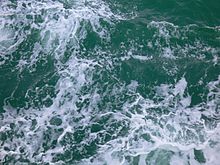The reason for why the sea water is salty is that, it contains dissolved salts in large amounts.
- 0
Sea water is salty because it contains large amounts of the salt Sodium Chloride. Salts are brought to the sea through many sources like rivers and streams which collect various minerals, salts and silt on their course and drain them into the oceans. Atmospheric phenomena like evaporation also increase the salt concentration in the oceans. Apart from these, the existing sediments and minerals present in the ocean bed add to the salinity. The high salt content in the sea water makes it unfit for human consumption. To compare the salinity of fresh water and sea water, it is said that sea water is 220 times saltier than normal fresh water. And the dead sea is 8.6 times saltier than the ocean water.
- 1
Wherever water comes into contact with the rocks of Earth’s crust, either on land or in the ocean or within the oceanic crust, some of the minerals in the rock dissolve and are carried by the water to the ocean. The salt content of seawater does not change because new minerals are forming on the sea floor at the same rate as salt is added. Thus, the salt content of the sea is at steady state.
- 0
mp to: navigation, search

Seawater is water from a sea or ocean. On average, seawater in the world's oceans has a salinity of about 3.5% (35 g/L, or 599 mM). This means that every kilogram (roughly one litre by volume) of seawater has approximately 35 grams (1.2 oz) of dissolved salts (predominantly sodium (Na+) and chloride (Cl−) ions). Average density at the surface is 1.025 g/ml. Seawater is denser than both fresh water and pure water (density 1.0 g/ml @ 4 °C (39 °F)) because the dissolved salts add mass without contributing significantly to the volume. The freezing point of seawater decreases as salt concentration increases. At typical salinity it freezes at about −2 °C (28 °F).[1] The coldest seawater ever recorded (in a liquid state) was in 2010, in a stream under an Antarctic glacier, and measured −2.6 °C (27.3 °F).[2]
- 0
- 0

